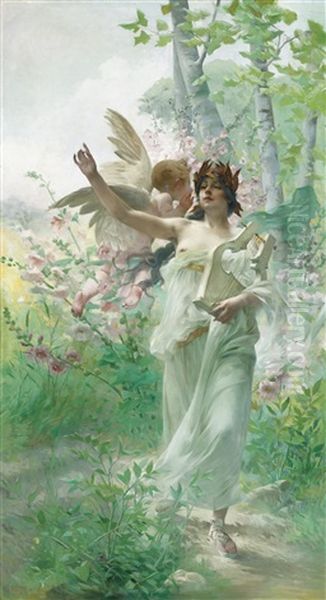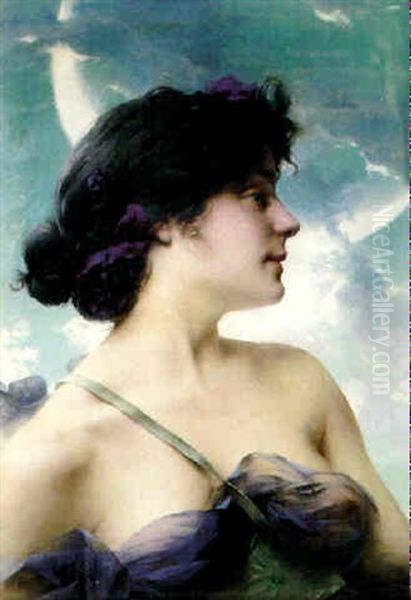Paul François Quinsac (1858-1929) stands as a distinguished figure in the landscape of late 19th and early 20th-century French art. A prominent exponent of the Academic tradition, Quinsac carved a niche for himself with his refined allegorical compositions, mythological scenes, and elegant female portraits. Often hailed as the "elegant painter of Bordeaux," his work embodies the precision, idealization, and thematic concerns characteristic of the official art establishment of his era, even as modern art movements began to challenge its dominance. His journey from the vineyards of Bordeaux to the prestigious Salons of Paris is a testament to his dedication and artistic prowess.
Early Life and Artistic Awakening in Bordeaux
Born on March 2, 1858, in Bordeaux, a city renowned for its wine and rich cultural heritage in southwestern France, Paul François Quinsac was immersed in an environment conducive to artistic appreciation from a young age. His father, a teacher at a local university, played a significant role in nurturing his son's early artistic inclinations. This familial encouragement provided a strong foundation for Quinsac's future pursuits, instilling in him a love for culture and the arts that would define his life.
Initially, Quinsac's artistic expression found an outlet in music. In 1878, he moved to Paris, the undisputed art capital of the world at the time, with the intention of furthering his musical studies. He briefly studied composition under the guidance of Henri Herz, a notable pianist and composer. However, the vibrant visual arts scene of Paris soon captivated him, and his passion gravitated decisively towards painting, setting him on a new artistic trajectory.
The Parisian Crucible: Training under Gérôme
Recognizing his true calling, Quinsac enrolled in the prestigious École des Beaux-Arts in Paris. This institution was the bastion of Academic art, upholding classical ideals and rigorous training methods. Here, he had the distinct privilege of studying under Jean-Léon Gérôme (1824-1904), one of the most influential and respected academic painters of the 19th century. Gérôme, known for his meticulously detailed historical scenes, Orientalist subjects, and polished technique, profoundly impacted his students.

Under Gérôme's tutelage, Quinsac honed his technical skills, mastering draftsmanship, anatomy, and composition according to the strict standards of the Academy. While Gérôme's direct influence can be seen in Quinsac's precision and polished finish, Quinsac would eventually channel these skills into his own preferred thematic domains, particularly allegory and idealized female figures, rather than Gérôme's more narrative historical or ethnographic subjects. Other prominent academic artists of the era, such as William-Adolphe Bouguereau and Alexandre Cabanel, also championed similar ideals of beauty and technical perfection, creating a rich context for Quinsac's development.
Emergence and Salon Success
The Paris Salon, officially the Salon des Artistes Français, was the paramount venue for artists to exhibit their work and gain recognition. Quinsac made his debut at the Salon in 1880, marking the beginning of a long and successful exhibiting career. His consistent participation and the quality of his submissions quickly garnered attention. He became a member of the Société des Artistes Français in 1887, a significant step in establishing his professional standing.
A pivotal moment in his early career came in 1889 (some sources suggest 1887 for a third-class medal, but 1889 is often cited for significant recognition related to his allegorical works). It was in this year, or around this period, that he received a third-class medal at the Salon, likely for works exhibited at a venue associated with the Montmartre art scene or the main Salon itself. This award solidified his reputation as a talented painter within the academic fold. His success at the Salon was crucial, as it provided visibility, critical appraisal, and access to patronage.
Artistic Style and Thematic Concerns
Quinsac's artistic style is firmly rooted in the Academic tradition, characterized by meticulous detail, smooth brushwork (a "licked finish"), and idealized forms. However, he infused his work with a distinct elegance and a penchant for Symbolist undertones, particularly in his allegorical pieces. He was a master of rendering textures, from flowing drapery to luminous skin, creating a sense of tactile reality within his idealized visions.
A significant portion of Quinsac's oeuvre is dedicated to allegorical subjects. He excelled at personifying abstract concepts, transforming ideas like music, painting, and sculpture into graceful female figures. These allegories were not merely decorative; they often conveyed a deep appreciation for the arts and the pursuit of beauty. His female portraits and nudes, such as "Violet Beauty" and "Woman in a Red Dress," celebrate feminine grace and charm, often imbued with a sense of modern sensibility blended with classical romanticism. These works reflect the Belle Époque's fascination with elegance and refined sensuality.

His landscapes, though perhaps less central to his fame than his figural work, also demonstrate his keen observational skills and ability to capture atmosphere. Throughout his career, Quinsac maintained a commitment to beauty and harmony, standing somewhat apart from the more radical artistic experiments of his contemporaries like the Impressionists or Post-Impressionists.
Key Works and Their Significance
Among Quinsac's most celebrated works are his allegorical triptychs or series. The "Allegory of Music," "Allegory of Painting," and "Allegory of Sculpture," all reportedly created around 1889, are prime examples of his skill in this genre. These paintings typically feature elegant female figures, often in classical attire or artfully draped, embodying the essence of each art form. Rendered in a harmonious, often cool and fresh color palette, these works showcase his ability to translate abstract ideas into compelling visual narratives. The figures are graceful, their poses conveying the spirit of the art they represent – the lyricism of music, the creative vision of painting, the tangible form of sculpture.
These allegories were highly esteemed and contributed significantly to his reputation. His success with such themes culminated in an honorary award at the Paris Universal Exposition of 1900, a major international event, where works like his allegories were showcased to a global audience, further cementing his status. Other works, such as his portraits and genre scenes, also contributed to his acclaim, demonstrating his versatility within the academic framework.
Quinsac and the Art World of His Time
Paul François Quinsac was not an isolated artist but an active participant in the art world of his era. His training under Gérôme placed him within a lineage of respected academic painters. Gérôme's studio was a hub for aspiring artists, and Quinsac would have been aware of fellow students and contemporaries who also passed through this influential atelier, such as Pascal Dagnan-Bouveret, who, though later associated with Naturalism, shared the rigorous academic grounding.
Quinsac's commitment to the academic system extended beyond his own painting. He took on leadership roles in artistic organizations, notably in his native Bordeaux. In 1906, he served as the president of the jury for the first annual exhibition of the "Association d’Artists Peintres, Sculpteurs, Architectes et Graviers Domiciliés à Bordeaux" (Association of Painters, Sculptors, Architects, and Engravers based in Bordeaux). This role indicates his respected standing among his peers and his dedication to fostering the arts in his home region.
While the provided information mentions his involvement with the "Living Art Exhibitions" executive committee and a 1944 White Stag Group exhibition under the name "Paul François Cusac," the latter date is problematic given Quinsac's death in 1929. It's possible this refers to a different artist or is a misattribution. However, his leadership in the Bordeaux artists' association is well-documented and aligns with his career trajectory.
His contemporaries in the broader French art scene included figures like Léon Bonnat, a renowned portraitist and influential teacher, and Jean-Paul Laurens, known for his historical paintings. While Symbolist artists like Gustave Moreau and Pierre Puvis de Chavannes explored allegorical and mythological themes with a different stylistic approach, they shared a common ground in their departure from strict realism towards more imaginative and evocative content. Quinsac's work, while more traditionally academic, resonated with the era's interest in symbolism and idealized beauty. Internationally, academic painters like Britain's Lord Frederic Leighton and Lawrence Alma-Tadema also enjoyed immense popularity for their classical and historical subjects, indicating a widespread appreciation for this mode of art.
Later Career, Teaching, and Recognition
Throughout his career, Quinsac continued to produce works that were admired for their elegance and technical skill. He also dedicated himself to teaching, passing on the academic tradition to a new generation of artists. One of his notable students was Pierre Bodard (1881-1937), who would go on to have his own successful career. This pedagogical role was common among established academic painters, ensuring the continuity of their artistic principles and techniques.
Quinsac's contributions to French art and culture were formally recognized with prestigious honors. In 1908, he was made a Chevalier of the Legion of Honour (Légion d'honneur), one of France's highest civilian decorations. This award signified national acknowledgment of his artistic achievements and his standing in the cultural life of the country.
Later in his life, in 1925, his connection to his home region was further solidified when he was honored by the Bordeaux Museum of Fine Arts, possibly through an affiliation with a local learned society such as the Académie Nationale des Sciences, Belles-Lettres et Arts de Bordeaux, which often inducted distinguished local figures. This recognition underscored his status as a leading artistic figure in Bordeaux. He also reportedly created illustrations for publications like the "French Post" magazine and designed commercial posters, showcasing a broader application of his artistic talents beyond the confines of Salon painting.
Legacy and Enduring Appeal
Paul François Quinsac passed away in May 1929 in his beloved Bordeaux, at the age of 71. He left behind a significant body of work that exemplifies the grace and technical mastery of French Academic painting. While the Academic tradition faced increasing challenges from avant-garde movements throughout his career, Quinsac remained a steadfast proponent of its ideals, adapting them with his own elegant sensibility.
His reputation as the "elegant painter of Bordeaux" endures, and his works are held in various public and private collections. While perhaps not as widely known today as some of his Impressionist or Post-Impressionist contemporaries like Claude Monet or Vincent van Gogh, or even more flamboyant academic figures like Bouguereau, Quinsac's art offers a valuable insight into the prevailing artistic tastes and standards of the Belle Époque. His paintings, particularly his allegories and female figures, continue to be admired for their refined beauty, delicate execution, and the serene, idealized world they depict. Artists like James Tissot, though focusing more on contemporary fashionable life, shared a similar commitment to elegant portrayals and meticulous detail that characterized the era's tastes.
Conclusion: A Master of Refined Academicism
Paul François Quinsac's career spanned a period of profound transformation in the art world. He navigated this era with a steadfast commitment to the principles of Academic art, enriched by his personal vision of elegance and beauty. From his early training under the formidable Jean-Léon Gérôme to his successes at the Paris Salon and his respected position in the Bordeaux art community, Quinsac consistently produced works of high technical quality and refined aesthetic appeal. His allegories, mythological scenes, and portraits remain as testaments to a painter who masterfully balanced classical ideals with a gentle, almost lyrical sensibility. As an art historian, one appreciates Quinsac not only for his individual talent but also as a significant representative of a major artistic tradition that shaped the cultural landscape of 19th and early 20th-century France. His legacy is one of elegance, skill, and an unwavering dedication to the art of painting.